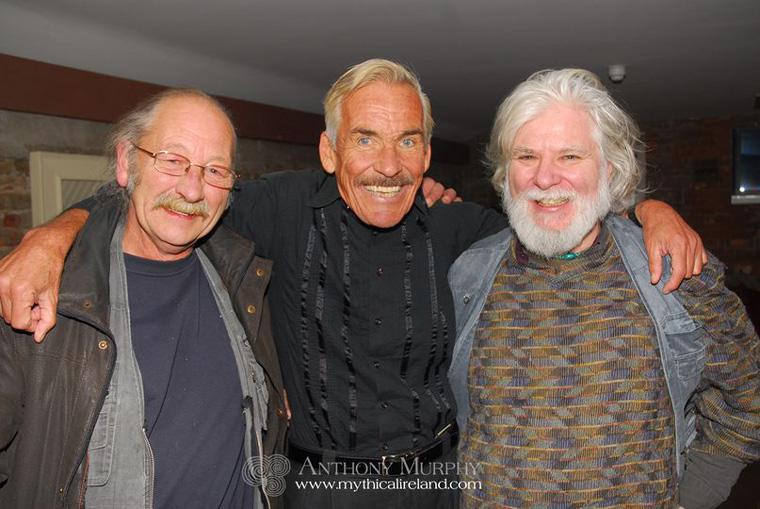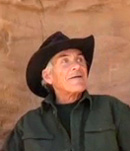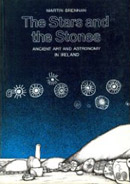The Stonelight Team
 Jack Roberts (left), Martin Brennan (centre) and Toby Hall (right). Photo by Anthony Murphy at the 'Boyne Valley Revision' conference at the Newgrange Lodge in December 2009.
Jack Roberts (left), Martin Brennan (centre) and Toby Hall (right). Photo by Anthony Murphy at the 'Boyne Valley Revision' conference at the Newgrange Lodge in December 2009.
 The
core group of Stonelight from the mid seventies was
Martin Brennan (1942-2023), Toby Hall and Jack Roberts (1950-2024).
The starting point of the work is the ongoing piecing together of the function
and purpose of the Irish Megalithic culture.
Many people have assisted over the years. Our initial feeling was that the
chambered cairns of Ireland, were much more than the 'tombs' they were and incredibly still are usually
labelled as.
The
core group of Stonelight from the mid seventies was
Martin Brennan (1942-2023), Toby Hall and Jack Roberts (1950-2024).
The starting point of the work is the ongoing piecing together of the function
and purpose of the Irish Megalithic culture.
Many people have assisted over the years. Our initial feeling was that the
chambered cairns of Ireland, were much more than the 'tombs' they were and incredibly still are usually
labelled as.
Despite constant references to wider and more uplifting functions from Ancient writings, through Borlase, AE, John Michael and many others, there remains a strange resistance to a multidisciplinary evaluation of their possible purpose.
In the early seventies Martin moved from Maya studies in Mexico to Japan, after some years in Japan where he had gained a black belt in Aikido, his teacher advised him to return to Ireland the land of his ancestors and to study the ancient megalithic culture. These researches led to his first book The Boyne Valley Vision, in which he advanced the groundwork that the messages inscribed on the kerbstones of the great Chambered Cairns, was astronomical in nature.
In this and his subsequent book The Stones of Time (Stars and the Stones, Art and Astronomy in ancient Ireland) Martin further advanced the astronomical achievements of the culture by revealing a series of sun and shadow sequences in the cairns at key times. The most spectacular being the sun crossing the glyphs on the backstone of Cairn T, Loughcrew during the equinoxes.
Other aspects of the cairns and culture have intrigued Stonelight folk and researchers from various disciplines, many adding to our knowledge of their purpose / function and often also their enigma! Verily they are the 'The Temples of the Ancestors', and to deliberately denigrate them is both inauspicious and unwise. Stonelight is dedicated to furtherance of our understanding of this heritage in both the fields of science and spirituality.
 The Stars and the Stones by Martin Brennan was published in 1983, it was later re-published as
The Stones of Time - Calendars, Sundials and Stone Chambers of Ancient Ireland.
A study of solar and lunar alignments at a number
of Irish Megalithic sites, in depth investigations of the Equinox sunrise alignment at Loughcrew
Cairn T and the Winter Solstice sunrise alignment at Newgrange.
The Stars and the Stones by Martin Brennan was published in 1983, it was later re-published as
The Stones of Time - Calendars, Sundials and Stone Chambers of Ancient Ireland.
A study of solar and lunar alignments at a number
of Irish Megalithic sites, in depth investigations of the Equinox sunrise alignment at Loughcrew
Cairn T and the Winter Solstice sunrise alignment at Newgrange.
Purchase at Amazon.com or Amazon.co.uk
Martin Brennan - Obituary
Martin V. Brennan, author, artist, megalithic discoverer, pioneer by Toby R Hall - December 2023Martin Vincent Brennan, 'Morsheen', was born of Irish parents from Roscommon and Galway on 16th June 1942 in Brooklyn, New York. The family lived close to the library, Natural Museum and Prospect Park. These three locations had an inspirational and creative impact on his life. The boy brought home a book on Chinese writing and glyphs, an art he continued throughout his life. He was a Daykeeper living and exploring time through the Azteca-Mayan Cosmology for many decades in Mexico.
In the Natural Museum his young mind was fascinated with wooden Mayan Temple reproductions and the Meso-American heritage. In Prospect Park, which was shaped and modelled around the shape of the island of Ireland, the land of his forbears, he embraced nature and his Irish roots. After college, his formal art training was in the Pratt Institute in Brooklyn, in visual communications, where guest lecturer, author and mythologist Joseph Campbell, presented the cross-cultural concept of the The Hero's Journey. During his time in Pratt he deepened his fascination with the Meso-American culture. From Pratt he moved into an advertising agency as a design and graphic artist. However, he was not destined to spend his days working the city and 'mad men' advertising industry - he was an explorer, a maverick. Growing up Brooklyn he had an exciting youth.
He was athletic and excellent runner and basketball player. In college he was rarely beaten on the track. He put this down not just natural athleticism but to his mental preparation, before the starting gun he envisioning himself as a horse. He was natural Shaman who connected with both the natural and spiritual worlds throughout his life.
He moved from New York to Mexico study Maya prehistoric rock inscriptions, art and ritual. He lived with an Indian family deep in Jalisco mountains, where he did extensive field work on local art and Shamanism. Whilst in Mexico, he met author Alan Watts, who was interested to learn more of Martin's Mayan research and arranged that he bring his findings along to show him and his friends the Randolph's who had an interest in art and the Meso American culture.
The meetings lead to new phase of his journey, Japan. The Randolphs helped him travel to and enrol in Shotokugi Zen Monastery, Japan's first/oldest Zen Monastery dating from 1322, where he studied Oriental art and calligraphy at Shotokugi. He also studied also Akido in which he acquired a Black Belt. He remained active at Akido, basketball and swimming into his 70s. By combining art and aikido he fundamentally embraced the ways of brush, (and pen) and sword. He was happiest when he was drawing. He embodied the way of artist, scholar, warrior and shaman. His Japanese Zen and Akido training along with his Mexican fieldwork and study of Shamanism, art and his visual communications experience made a good grounding for his next area of focus, the Boyne Valley monuments and Irish Megalithic culture - areas in which he was to make unique groundbreaking and valuable discoveries.
This move to Ireland came about through his esteemed Japanese, Celtic scholar, teacher who suggested he travel to Ireland land of his parents and study the ancient culture. In 1970 he left Japan for Ireland and the Boyne Valley. He, settled in top floor flat in Fitzwilliam Street. He worked in Graphic Design and Advertising, working at the Peter Owen's Agency. He founded an official Akido Dojo in Trinity college. Several of his Japanese teachers visited to celebrate the founding of the Akido project and to initiate the work into Boyne Valley culture as a Cultural Spiritual undertaking.
Between the glyphs on the kerb stones, drawings and photographs, Martin soon deduced that the enigmatic designs in part were depictions of astronomical symbols, the sun and moon and cosmological cycles. The fruits of this research are to found in his two Irish books, The Boyne Valley Vision, Dolmen Press 1979 and The Stars and the Stones, Thames and Hudson 1982. Republished by Inner Traditions USA in 1994 as, The Stones of Time.
Martin handcrafted his books. He wrote them in his distinctive longhand and they were adorned with his beautiful and distinctive drawings. He would start a book by designing the cover, meet with the publisher and progress from there. His enthusiastic and charismatic presentations of the research intrigued and found favour with the eminent publishers, Dolmen Press and Thames and Hudson.
This latter was helped by front page news stories of groundbreaking discoveries of the sun entering the recess's of the chamber cairns, Cairn T and Cairn L, in the Loughcrew Hills on the vernal equinox and cross quarter day respectively and his friendship author John Michell. To catch the sun entering the chambers one had to be up early and drive to the Boyne Valley or Loughcrew Hills and to climb the hill to be in place for the sun or moon to shine in. The logistics of this led to the need for one or two cars and small group of observers to be in the selected cairns. This loose collective of megalithic enthusiasts went under the title Stonelight. The equinox sun beam was the bringing to life of the 5,000 year old glyphs as the sun beam moved across the backstone in Cairn T.
The sunbeam penetrating the dark cairn/womb and illuminating the symbols breathed life and light into the monument as it revealed its astronomical function as a calendrical device of great antiquity and sophistication. Martin hoped with the publication of The Stars and Stones, the catch-all diminutive tomb theory/burial mound label would be laid to rest and the abodes of the Daghda, Aengus and the pantheon of historic/mythic residents of the wonderful cairn/residences/sacred mounds would be recognised as sacred, scientific edifices - 'Temples of the Ancestors'.
Shortly after the publication of The Stars and Stones, Martin unexpectedly needed to return to New York. Regrettably the revelations of "the golden secrets of our past" as astromegailtic-cosmological temples was ignored and even ridiculed. In part, it must be said because these discoveries came from outside the doors of the establishment dogmatic tomb theory orthodoxy.
Martin moved from New York to Boulder, CO, where he taught and trained a local basketball team based on Akido principles. Here he produced his third book, The Hidden Maya (1998, Bear and Company) in which he decoded the enigmatic hand sign language depicted in Aztec and Mayan codices, rock carvings and pottery. His breakthrough for came from his realisation that the sign language of plains Indian's had roots in the earlier Meno-American hand sign language and was able reverse deduce these hand gestures.
He did extensive work in decoding the Codex Borgia and Azteca-Maya Calendar system. To his last day kept Azteca-Mayan day-keeping journals where he wrote in Gaelic, Chinese, Japanese, and with Azteca-Mayan glyphs that in detail recorded the subtle intricacies of each day. He was regarded as an author's author. Publishers liked to publish him for unique scholarship rather than just projected sales; they recognised the intrinsic value of his work.
In 2009, Anthony Murphy author and curator Mythical Ireland, instigated a plan with Stonelight friends of Martin bring him 'home' for a winter solstice conference in the Boyne Valley. This trip was a joy for Martin as he met many old friends and good number of archaeologists including George Eogan, excavator of the extraordinary Knowth megalithic complex. Martin had hoped that his astro-calendrical discoveries would be accepted and bury the the tomb moniker after the 30 year 'acclimation' period. Alas, he did not live long enough to see that change.
Martin died on 1st November 2023 after a fall and short hospitalisation, close to Puerto Vallarta, Mexico where he lived for over a decade. He will be greatly missed by many who hoped and expected that he would live to see the publication of more of his deep insights into nature of time. He was an erudite maverick, a lifelong bachelor, genius, author, teacher and shaman who lived a full life on his own terms. His decade in Ireland added greatly to the comprehension of our nation's scientific and spiritual roots. May he rest in peace.
Jack Roberts - Obituary
It is with great sadness that we mark the passing of Jack Roberts, artist, author, and explorer of Ireland’s prehistoric monuments. His love of ancient Ireland and his remarkable ability to communicate that passion made him one of the most influential independent researchers of his time. His books and talks inspired many of us to look more closely at the sacred landscape of Ireland, to see in the stones not only archaeology but art, astronomy, and spirit.Jack was born in England and began his working life as a fisherman. By his own account, one fateful voyage brought his trawler to the coast of Cork, where he saw Ireland appear out of the mist like Tír na nÓg. He stepped ashore and never left. From that day forward, Ireland became both his home and his muse.
In the 1970s, Jack joined a small but visionary circle of researchers, among them Martin Brennan and Toby Hall, who explored Ireland’s megalithic monuments with fresh curiosity and determination. Together they spent long nights inside chambered cairns and stone circles, waiting to see how sunlight or moonlight might touch the carvings on stones first inscribed five thousand years ago. Their work revealed astronomical alignments at sites such as Dowth, Loughcrew, and the stone circles of West Cork, reshaping how we understand Ireland’s Neolithic builders.
Jack’s contribution extended far beyond fieldwork. He had an artist’s eye and a gift for conveying what he saw. His early publication Sketches of Ancient Carbery – The Megaliths of West Cork captured the spirit of those stones with rare sensitivity. Later works such as The Sun Circles of Ireland and Sacred Mythological Centres of Ireland brought together archaeology, mythology, and astronomy in a voice that was uniquely his own. He was also a skilled craftsman, creating jewellery inspired by megalithic art and selling it at markets around Galway and the west, always happy to share the stories behind the symbols.
Though he spent most of his life in Ireland, Jack never lost his Cockney accent or his down to earth humour. Friends and fellow researchers remember him as warm, curious, and generous with his time. He was the kind of man who made everyone feel welcome, whether in a stone circle at dawn or over a cup of tea on a rainy afternoon.
Jack Roberts passed away in 2024, leaving behind a legacy that endures in his books, his drawings, and in the countless people he inspired to look more deeply into the ancient landscape of Ireland. Every winter solstice at Dowth or equinox morning at Loughcrew stands as a quiet tribute to his work. moments of light and wonder that continue to reveal the world as he helped us to see it.
Boyne Valley Private Day Tour
 Immerse yourself in the rich heritage and culture of the Boyne Valley with our full-day private tours.
Visit Newgrange World Heritage site, explore the Hill of Slane, where Saint Patrick famously lit the Paschal fire.
Discover the Hill of Tara, the ancient seat of power for the High Kings of Ireland.
Book Now
Immerse yourself in the rich heritage and culture of the Boyne Valley with our full-day private tours.
Visit Newgrange World Heritage site, explore the Hill of Slane, where Saint Patrick famously lit the Paschal fire.
Discover the Hill of Tara, the ancient seat of power for the High Kings of Ireland.
Book Now
Home
| Visitor Centre
| Tours
| Winter Solstice
| Solstice Lottery
| Images
| Local Area
| News
| Knowth
| Dowth
| Articles
| Art
| Books
| Directions
| Accommodation
| Contact

